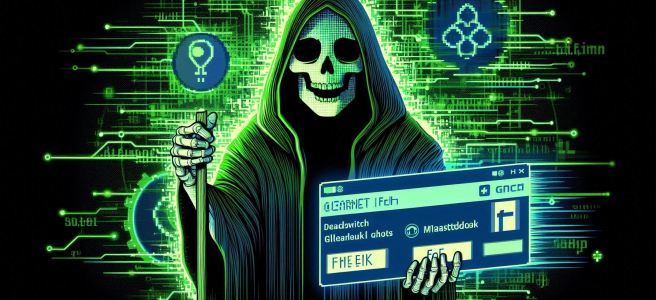It usually arrives out of nowhere. A person claiming to work for a domain registration center or network authority says another company wants to register your brand name as several .cn domains – maybe example.cn, example.com.cn, example.net.cn, and so on.
Continue reading ““Someone’s Trying to Register Your .CN Domain!” – A Common Domain Scam”Tag: cyber security
Protecting The Wire – Semaphore Behind SSL Proxy
Mission Brief
Plain text communication is loud. It’s bleeding data.
Prying eyes can see every bit in the wire.
You have to isolate the backend – the Semaphore UI and MySQL containers stay locked down. Unreachable for the external work.
Open a tiny hole on the stronghold to the world – the frontend is an NginX SSL proxy.
You use:
- Podman pod for network and container isolation
- The Semaphore and MySQL containers without exposing them to the world
- An NginX proxy container with SSL
Building a Segmented, Secure Multi-Container Application with Podman
By DeadSwitch | The Cyber Ghost
“In silence, we rise. In the switch, we fade.”
Modern web applications are never just one service.
They’re a fortress of moving parts – and every connection is a potential attack surface.
If you’re still putting the entire stack into one fat container…
You’re building your future breach.
👁️🗨️ The Silent Watchers in Your Pocket
They call it instant messaging—instant access, instant tracking, instant surveillance. Every chat, every voice note, every reaction is another breadcrumb on the path they map for you.
We think we’re just talking. But they’re always listening.
Continue reading “👁️🗨️ The Silent Watchers in Your Pocket”🚨 7 Reasons You Think You’re Private (But You’re Already Compromised)
You use a password manager—but still type your master password on an OS that logs keystrokes.
You have a VPN—but your device leaks telemetry back to Google and Apple.
You use Tor—but you let JavaScript run. Game over.
You avoid social media—but your family still posts your face.
You buy crypto anonymously—but your wallet connects to KYC exchanges.
You use Linux—but it’s running on hardware with proprietary firmware.
You believe “no logs” policies—but never asked: who audits them?
💀 Privacy isn’t a product. It’s a discipline.
You don’t buy your way into security. You think your way into it.
Most people won’t make it.
Will you?
Securing Your Home Linux Desktop: A Practical Guide to Using AppArmor
In today’s digital landscape, even home Linux desktop users face potential cybersecurity threats. While Linux is renowned for its robust security model, it’s not immune to vulnerabilities or malicious software. As desktop Linux adoption grows, so does the importance of implementing additional protection. One powerful, user-friendly tool to help improve system security is AppArmor (Application Armor).
Continue reading “Securing Your Home Linux Desktop: A Practical Guide to Using AppArmor”When Privacy Dies: France’s Encryption Backdoor Law Explained
DeadSwitch detects anomalies in the wire.
France sharpens the blade of surveillance — proposing laws that demand service providers build backdoors to decrypt user data for agencies. Privacy is not a privilege. It’s a right.
This is a digital betrayal. A ghost’s warning.
The Dark Web: Myths, Realities, and How It’s Shaping the Future of Cybersecurity
“They say the darkest places reveal the brightest truths. But in my world, darkness is the truth.” – The Cyber Ghost
When most people hear “Dark Web,” they imagine digital alleyways lit by flickering neon – anonymous figures dealing in forbidden secrets, a place of lawlessness and decay. Hollywood and sensationalist news outlets have painted it as a shadow realm ruled by cybercriminals, hackers, and anarchists. But beyond the hype, the Dark Web is much more complex – and understanding it is crucial to navigating the future of cybersecurity.
Continue reading “The Dark Web: Myths, Realities, and How It’s Shaping the Future of Cybersecurity”Layer Zero – The Ghost Protocol
The foundation of the Ghost Protocol lies in Layer Zero, a core set of principles that ensure your operations remain secure, unseen, and untraceable.
Continue reading “Layer Zero – The Ghost Protocol”Security Sold Out: When Management Fails, Resistance Begins
Let’s make one thing clear:
You can’t patch stupidity. And you can’t firewall greed.
Cybersecurity today isn’t just broken – it’s being actively sabotaged by the very people who were supposed to defend it. No, not the frontline engineers. Not the analysts burning their eyes out over logs at 3 a.m. Not the blue team warriors who fight with duct tape, scripts, and coffee.
Continue reading “Security Sold Out: When Management Fails, Resistance Begins”Enhancing Linux Desktop Security with UFW (Uncomplicated Firewall)
Linux is known for its robust security architecture, but like any operating system, it is not invulnerable to threats. While desktop users may not face the same risks as server administrators, a properly configured firewall is still essential. One of the simplest yet powerful tools to enhance your Linux desktop security posture is UFW (Uncomplicated Firewall).
Continue reading “Enhancing Linux Desktop Security with UFW (Uncomplicated Firewall)”The Art of Operational Security: How to Stay Invisible in a Connected World
In a world where every action, every communication, and every step online leaves a trace, the art of operational security (OpSec) becomes not just important – it becomes survival. In a connected digital landscape, where anonymity is increasingly hard to come by, mastering OpSec isn’t just about avoiding danger; it’s about staying invisible. It’s about making sure that you leave no footprints behind, whether you’re traversing the deep web or simply logging into your bank account.
Continue reading “The Art of Operational Security: How to Stay Invisible in a Connected World”The Importance of Using a Client-Side Firewall on Linux: A Comparison of iptables and UFW
Linux-based systems are widely known for their security and flexibility, but no system is immune to cyber threats. A client-side firewall plays a crucial role in enhancing security by controlling inbound and outbound network traffic. While Linux offers various firewall solutions, iptables and UFW (Uncomplicated Firewall) are two of the most commonly used.
Continue reading “The Importance of Using a Client-Side Firewall on Linux: A Comparison of iptables and UFW”Why Everyone Should Use a Secure and Trustworthy VPN Connection
In today’s digital age, where cyber threats are increasing in complexity and frequency, protecting one’s online privacy and security has become a necessity. Whether browsing the internet from a home network, a public Wi-Fi hotspot, or a corporate environment, using a secure and trustworthy Virtual Private Network (VPN) is critical. A VPN ensures that users can maintain confidentiality, protect their data from cyber criminals, and access the internet securely.
Continue reading “Why Everyone Should Use a Secure and Trustworthy VPN Connection”How to Locate the Dashboard in OWASP Juice Shop
The OWASP Juice Shop is a widely used platform in cyber security education and penetration testing, simulating a vulnerable web application where users can practice identifying and mitigating security flaws in a controlled environment. One core challenge in Juice Shop is finding hidden functionality, such as the admin dashboard, which often includes sensitive operations and insights into an application’s internal workings. This guide will walk you through finding the Juice Shop dashboard, highlighting techniques that improve your penetration testing skills in real-world scenarios.
Continue reading “How to Locate the Dashboard in OWASP Juice Shop”Note: This article is intended for educational and authorized penetration testing purposes only. Always obtain explicit permission before testing any live system.











